Quality Management Application in Woolworths Supermarket, Australia
VerifiedAdded on 2023/06/05
|9
|1746
|59
Report
AI Summary
This report assesses the quality management practices at Woolworths Supermarket in Australia, focusing on the implementation of the Plan-Do-Check-Act (PDCA) cycle and the cause and effect diagram to address key issues within the organization. It highlights the supermarket's condition, including challenges related to customer preferences, supply chain management, product quality, and internal communication. The report details how these quality management tools can be applied to identify defects, improve employee satisfaction through better training and reward systems, and enhance overall operational efficiency by addressing the changing market trends and implementing advanced technologies like RFID and mobile payment solutions. Ultimately, the report emphasizes the importance of these strategies in achieving sustainable growth and maintaining a competitive edge in the Australian retail market, offering insights into the specific processes and steps required for successful implementation.
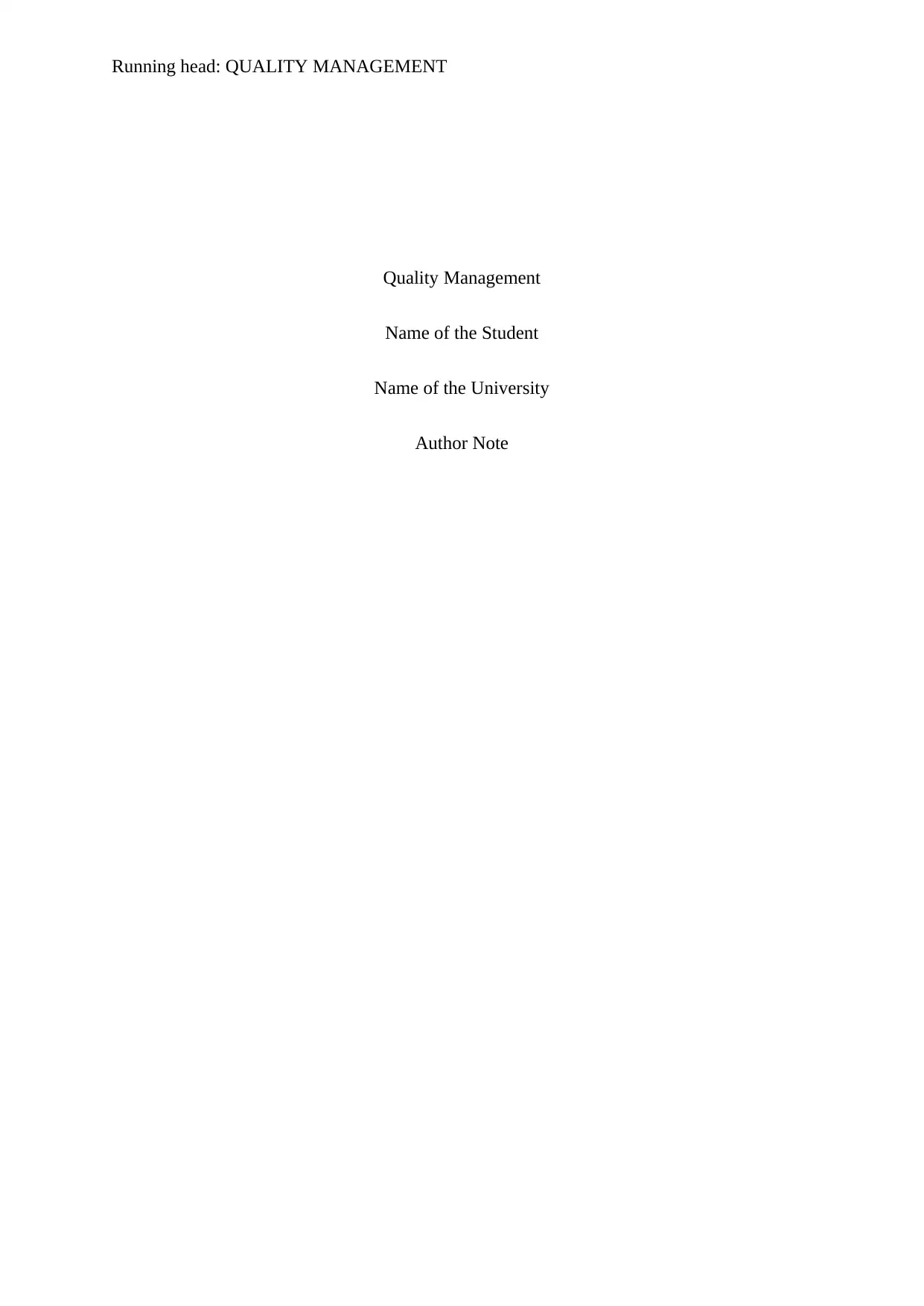
Running head: QUALITY MANAGEMENT
Quality Management
Name of the Student
Name of the University
Author Note
Quality Management
Name of the Student
Name of the University
Author Note
Paraphrase This Document
Need a fresh take? Get an instant paraphrase of this document with our AI Paraphraser
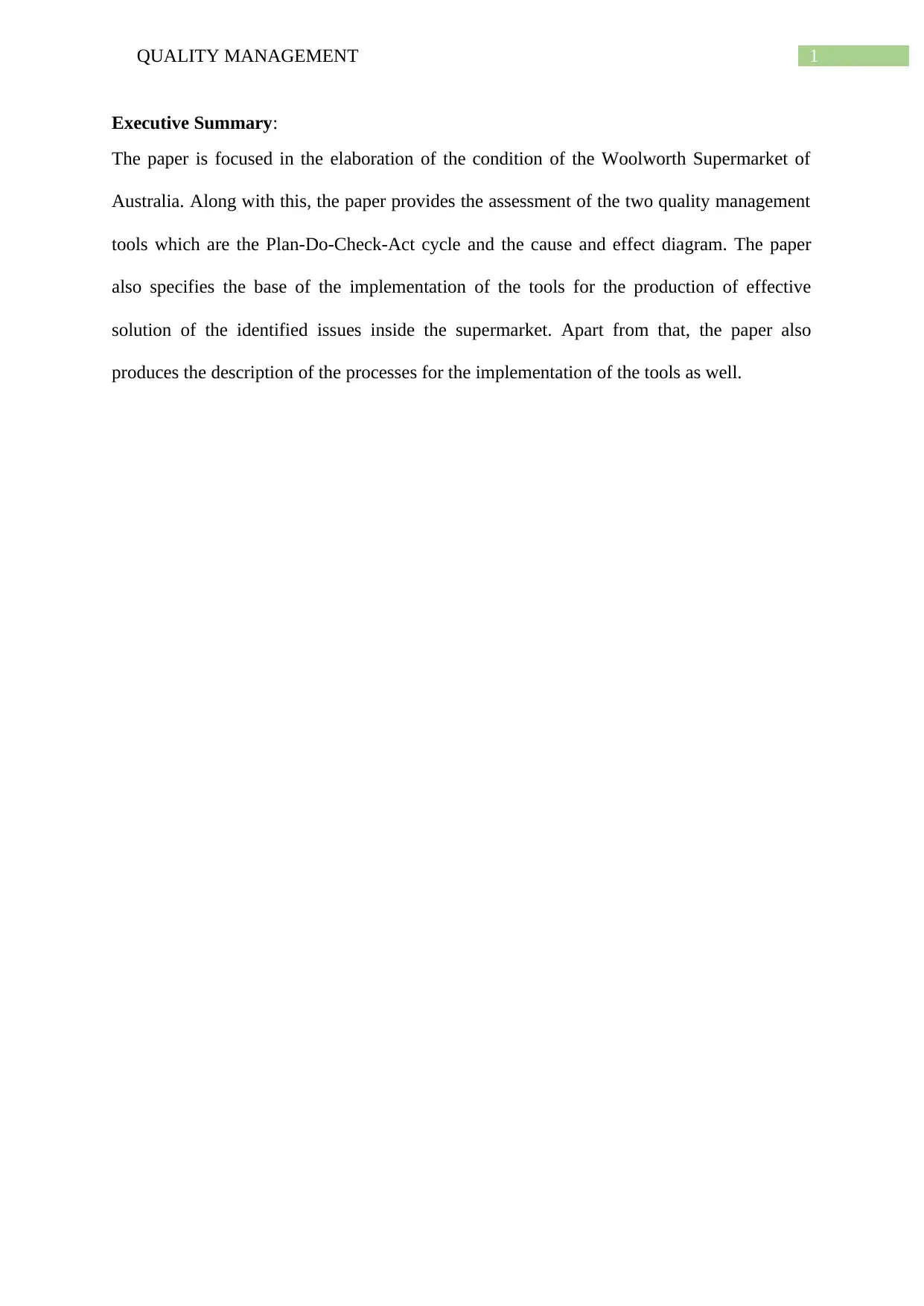
1QUALITY MANAGEMENT
Executive Summary:
The paper is focused in the elaboration of the condition of the Woolworth Supermarket of
Australia. Along with this, the paper provides the assessment of the two quality management
tools which are the Plan-Do-Check-Act cycle and the cause and effect diagram. The paper
also specifies the base of the implementation of the tools for the production of effective
solution of the identified issues inside the supermarket. Apart from that, the paper also
produces the description of the processes for the implementation of the tools as well.
Executive Summary:
The paper is focused in the elaboration of the condition of the Woolworth Supermarket of
Australia. Along with this, the paper provides the assessment of the two quality management
tools which are the Plan-Do-Check-Act cycle and the cause and effect diagram. The paper
also specifies the base of the implementation of the tools for the production of effective
solution of the identified issues inside the supermarket. Apart from that, the paper also
produces the description of the processes for the implementation of the tools as well.
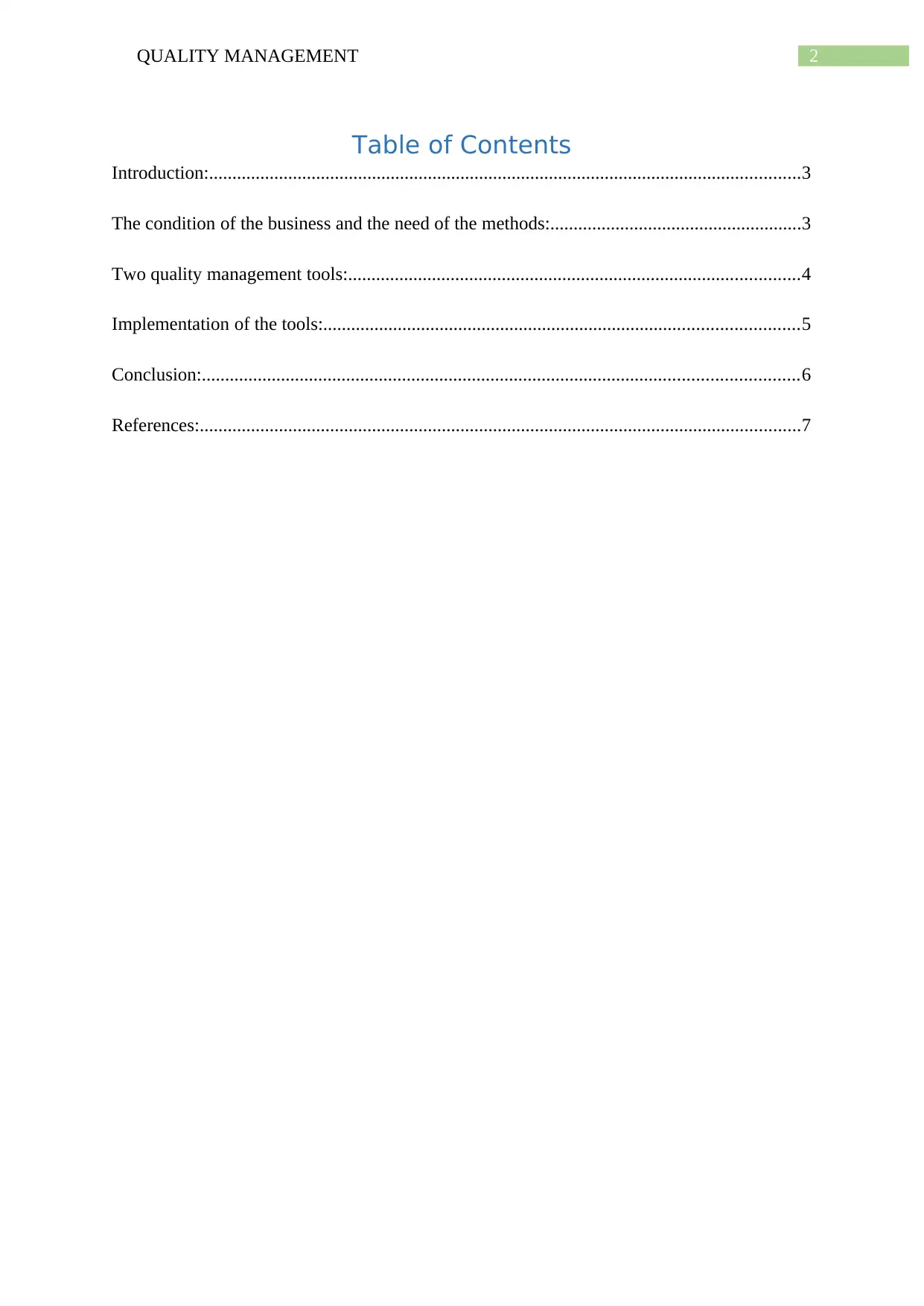
2QUALITY MANAGEMENT
Table of Contents
Introduction:...............................................................................................................................3
The condition of the business and the need of the methods:......................................................3
Two quality management tools:.................................................................................................4
Implementation of the tools:......................................................................................................5
Conclusion:................................................................................................................................6
References:.................................................................................................................................7
Table of Contents
Introduction:...............................................................................................................................3
The condition of the business and the need of the methods:......................................................3
Two quality management tools:.................................................................................................4
Implementation of the tools:......................................................................................................5
Conclusion:................................................................................................................................6
References:.................................................................................................................................7
⊘ This is a preview!⊘
Do you want full access?
Subscribe today to unlock all pages.

Trusted by 1+ million students worldwide
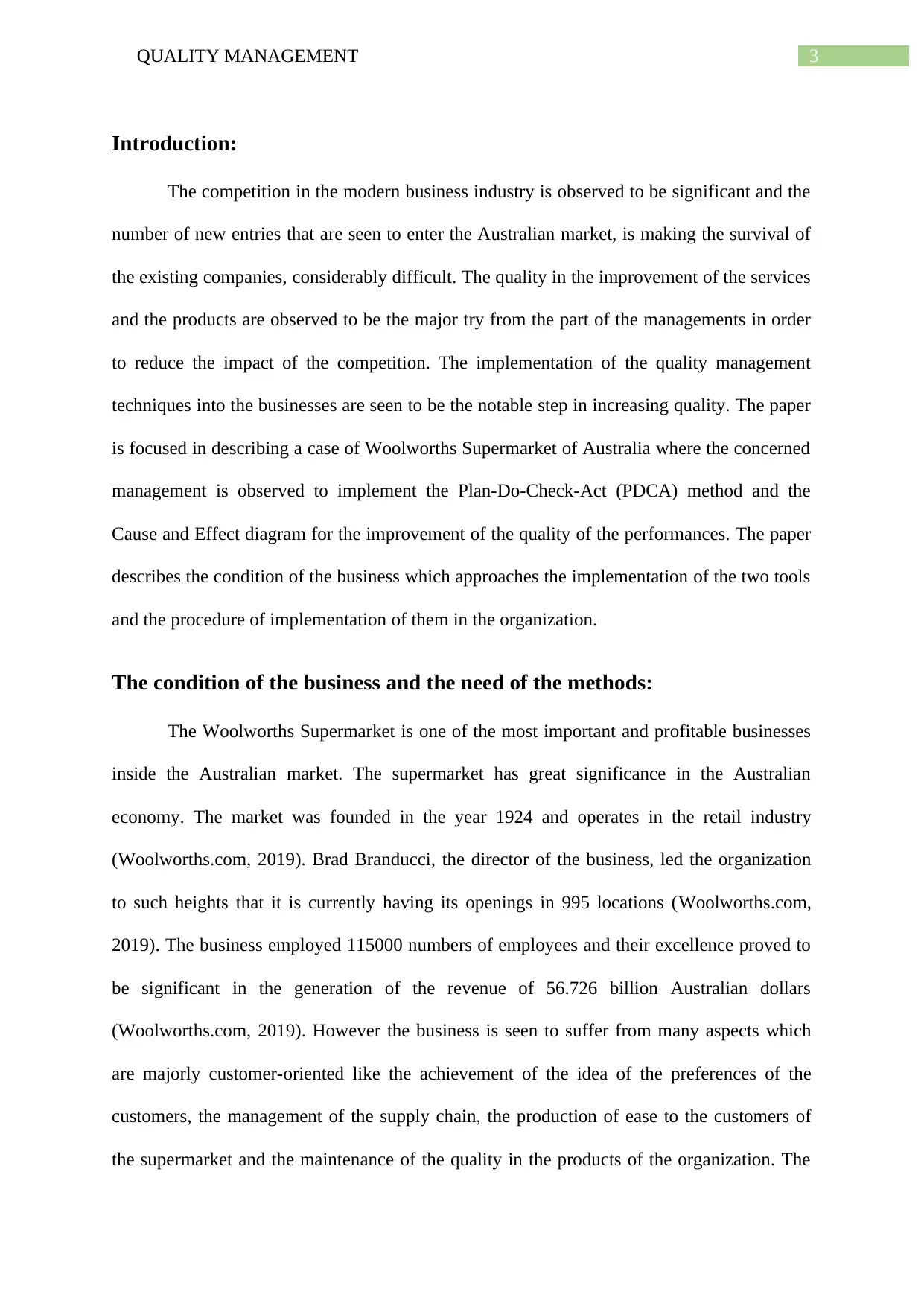
3QUALITY MANAGEMENT
Introduction:
The competition in the modern business industry is observed to be significant and the
number of new entries that are seen to enter the Australian market, is making the survival of
the existing companies, considerably difficult. The quality in the improvement of the services
and the products are observed to be the major try from the part of the managements in order
to reduce the impact of the competition. The implementation of the quality management
techniques into the businesses are seen to be the notable step in increasing quality. The paper
is focused in describing a case of Woolworths Supermarket of Australia where the concerned
management is observed to implement the Plan-Do-Check-Act (PDCA) method and the
Cause and Effect diagram for the improvement of the quality of the performances. The paper
describes the condition of the business which approaches the implementation of the two tools
and the procedure of implementation of them in the organization.
The condition of the business and the need of the methods:
The Woolworths Supermarket is one of the most important and profitable businesses
inside the Australian market. The supermarket has great significance in the Australian
economy. The market was founded in the year 1924 and operates in the retail industry
(Woolworths.com, 2019). Brad Branducci, the director of the business, led the organization
to such heights that it is currently having its openings in 995 locations (Woolworths.com,
2019). The business employed 115000 numbers of employees and their excellence proved to
be significant in the generation of the revenue of 56.726 billion Australian dollars
(Woolworths.com, 2019). However the business is seen to suffer from many aspects which
are majorly customer-oriented like the achievement of the idea of the preferences of the
customers, the management of the supply chain, the production of ease to the customers of
the supermarket and the maintenance of the quality in the products of the organization. The
Introduction:
The competition in the modern business industry is observed to be significant and the
number of new entries that are seen to enter the Australian market, is making the survival of
the existing companies, considerably difficult. The quality in the improvement of the services
and the products are observed to be the major try from the part of the managements in order
to reduce the impact of the competition. The implementation of the quality management
techniques into the businesses are seen to be the notable step in increasing quality. The paper
is focused in describing a case of Woolworths Supermarket of Australia where the concerned
management is observed to implement the Plan-Do-Check-Act (PDCA) method and the
Cause and Effect diagram for the improvement of the quality of the performances. The paper
describes the condition of the business which approaches the implementation of the two tools
and the procedure of implementation of them in the organization.
The condition of the business and the need of the methods:
The Woolworths Supermarket is one of the most important and profitable businesses
inside the Australian market. The supermarket has great significance in the Australian
economy. The market was founded in the year 1924 and operates in the retail industry
(Woolworths.com, 2019). Brad Branducci, the director of the business, led the organization
to such heights that it is currently having its openings in 995 locations (Woolworths.com,
2019). The business employed 115000 numbers of employees and their excellence proved to
be significant in the generation of the revenue of 56.726 billion Australian dollars
(Woolworths.com, 2019). However the business is seen to suffer from many aspects which
are majorly customer-oriented like the achievement of the idea of the preferences of the
customers, the management of the supply chain, the production of ease to the customers of
the supermarket and the maintenance of the quality in the products of the organization. The
Paraphrase This Document
Need a fresh take? Get an instant paraphrase of this document with our AI Paraphraser
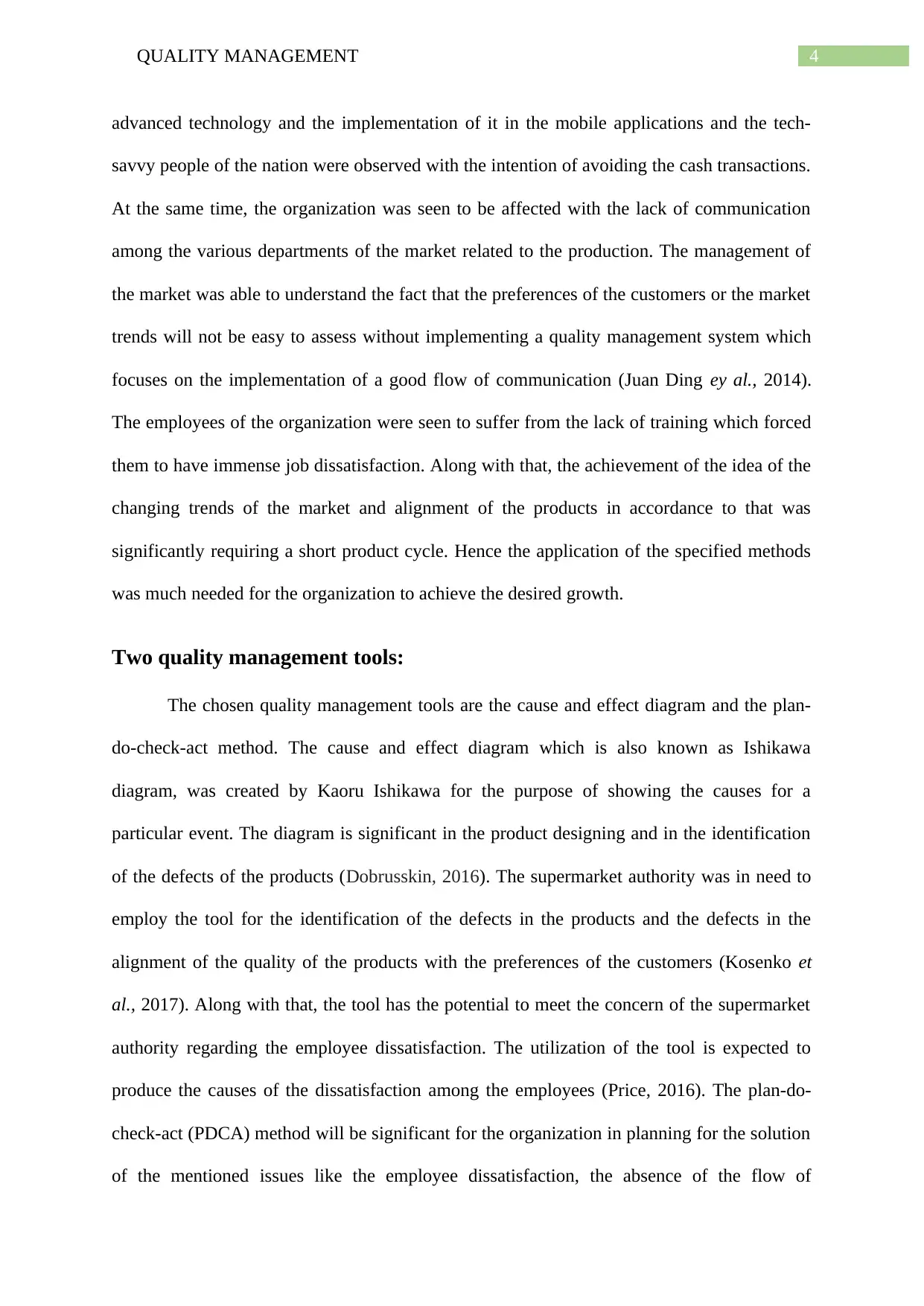
4QUALITY MANAGEMENT
advanced technology and the implementation of it in the mobile applications and the tech-
savvy people of the nation were observed with the intention of avoiding the cash transactions.
At the same time, the organization was seen to be affected with the lack of communication
among the various departments of the market related to the production. The management of
the market was able to understand the fact that the preferences of the customers or the market
trends will not be easy to assess without implementing a quality management system which
focuses on the implementation of a good flow of communication (Juan Ding ey al., 2014).
The employees of the organization were seen to suffer from the lack of training which forced
them to have immense job dissatisfaction. Along with that, the achievement of the idea of the
changing trends of the market and alignment of the products in accordance to that was
significantly requiring a short product cycle. Hence the application of the specified methods
was much needed for the organization to achieve the desired growth.
Two quality management tools:
The chosen quality management tools are the cause and effect diagram and the plan-
do-check-act method. The cause and effect diagram which is also known as Ishikawa
diagram, was created by Kaoru Ishikawa for the purpose of showing the causes for a
particular event. The diagram is significant in the product designing and in the identification
of the defects of the products (Dobrusskin, 2016). The supermarket authority was in need to
employ the tool for the identification of the defects in the products and the defects in the
alignment of the quality of the products with the preferences of the customers (Kosenko et
al., 2017). Along with that, the tool has the potential to meet the concern of the supermarket
authority regarding the employee dissatisfaction. The utilization of the tool is expected to
produce the causes of the dissatisfaction among the employees (Price, 2016). The plan-do-
check-act (PDCA) method will be significant for the organization in planning for the solution
of the mentioned issues like the employee dissatisfaction, the absence of the flow of
advanced technology and the implementation of it in the mobile applications and the tech-
savvy people of the nation were observed with the intention of avoiding the cash transactions.
At the same time, the organization was seen to be affected with the lack of communication
among the various departments of the market related to the production. The management of
the market was able to understand the fact that the preferences of the customers or the market
trends will not be easy to assess without implementing a quality management system which
focuses on the implementation of a good flow of communication (Juan Ding ey al., 2014).
The employees of the organization were seen to suffer from the lack of training which forced
them to have immense job dissatisfaction. Along with that, the achievement of the idea of the
changing trends of the market and alignment of the products in accordance to that was
significantly requiring a short product cycle. Hence the application of the specified methods
was much needed for the organization to achieve the desired growth.
Two quality management tools:
The chosen quality management tools are the cause and effect diagram and the plan-
do-check-act method. The cause and effect diagram which is also known as Ishikawa
diagram, was created by Kaoru Ishikawa for the purpose of showing the causes for a
particular event. The diagram is significant in the product designing and in the identification
of the defects of the products (Dobrusskin, 2016). The supermarket authority was in need to
employ the tool for the identification of the defects in the products and the defects in the
alignment of the quality of the products with the preferences of the customers (Kosenko et
al., 2017). Along with that, the tool has the potential to meet the concern of the supermarket
authority regarding the employee dissatisfaction. The utilization of the tool is expected to
produce the causes of the dissatisfaction among the employees (Price, 2016). The plan-do-
check-act (PDCA) method will be significant for the organization in planning for the solution
of the mentioned issues like the employee dissatisfaction, the absence of the flow of
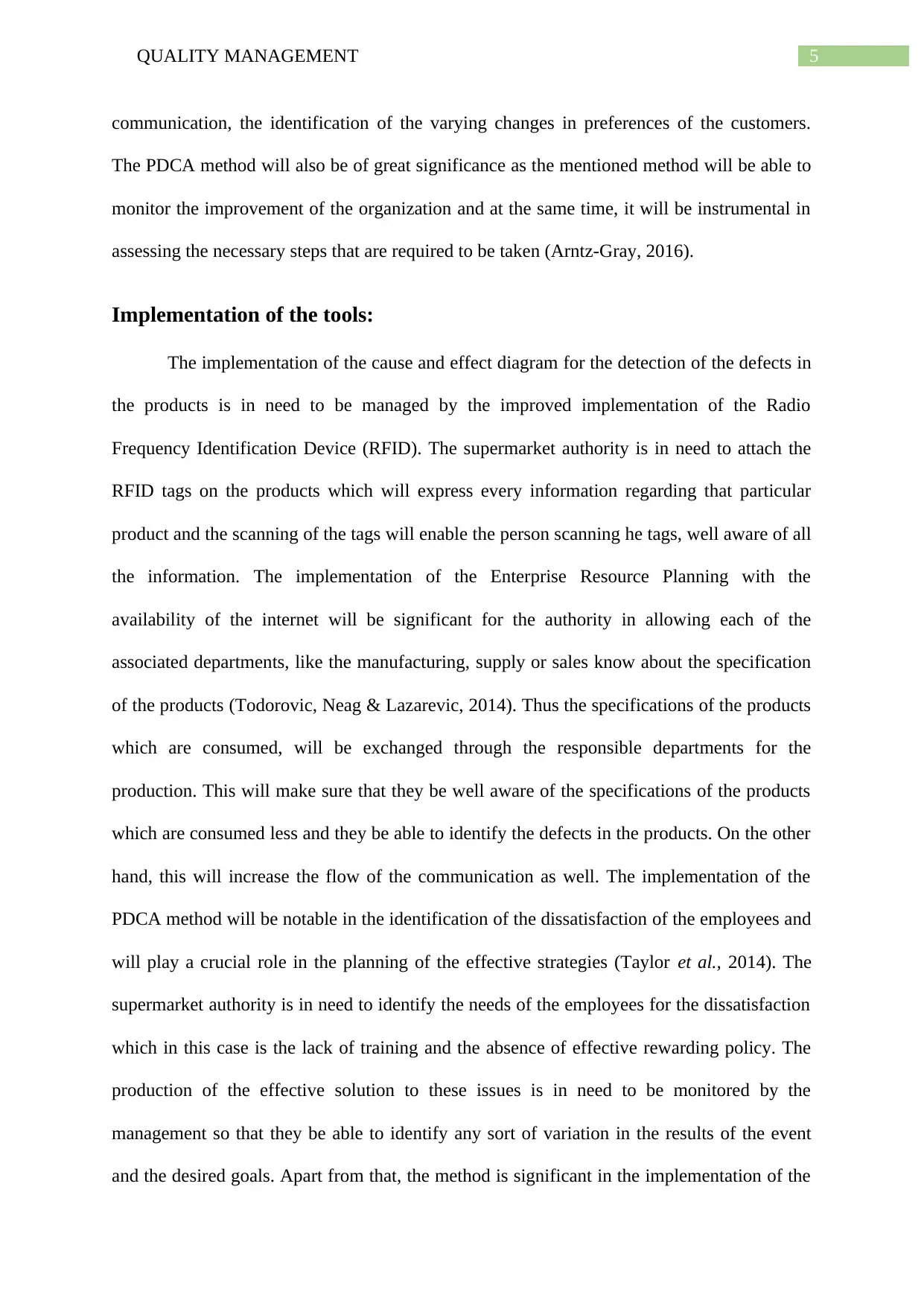
5QUALITY MANAGEMENT
communication, the identification of the varying changes in preferences of the customers.
The PDCA method will also be of great significance as the mentioned method will be able to
monitor the improvement of the organization and at the same time, it will be instrumental in
assessing the necessary steps that are required to be taken (Arntz-Gray, 2016).
Implementation of the tools:
The implementation of the cause and effect diagram for the detection of the defects in
the products is in need to be managed by the improved implementation of the Radio
Frequency Identification Device (RFID). The supermarket authority is in need to attach the
RFID tags on the products which will express every information regarding that particular
product and the scanning of the tags will enable the person scanning he tags, well aware of all
the information. The implementation of the Enterprise Resource Planning with the
availability of the internet will be significant for the authority in allowing each of the
associated departments, like the manufacturing, supply or sales know about the specification
of the products (Todorovic, Neag & Lazarevic, 2014). Thus the specifications of the products
which are consumed, will be exchanged through the responsible departments for the
production. This will make sure that they be well aware of the specifications of the products
which are consumed less and they be able to identify the defects in the products. On the other
hand, this will increase the flow of the communication as well. The implementation of the
PDCA method will be notable in the identification of the dissatisfaction of the employees and
will play a crucial role in the planning of the effective strategies (Taylor et al., 2014). The
supermarket authority is in need to identify the needs of the employees for the dissatisfaction
which in this case is the lack of training and the absence of effective rewarding policy. The
production of the effective solution to these issues is in need to be monitored by the
management so that they be able to identify any sort of variation in the results of the event
and the desired goals. Apart from that, the method is significant in the implementation of the
communication, the identification of the varying changes in preferences of the customers.
The PDCA method will also be of great significance as the mentioned method will be able to
monitor the improvement of the organization and at the same time, it will be instrumental in
assessing the necessary steps that are required to be taken (Arntz-Gray, 2016).
Implementation of the tools:
The implementation of the cause and effect diagram for the detection of the defects in
the products is in need to be managed by the improved implementation of the Radio
Frequency Identification Device (RFID). The supermarket authority is in need to attach the
RFID tags on the products which will express every information regarding that particular
product and the scanning of the tags will enable the person scanning he tags, well aware of all
the information. The implementation of the Enterprise Resource Planning with the
availability of the internet will be significant for the authority in allowing each of the
associated departments, like the manufacturing, supply or sales know about the specification
of the products (Todorovic, Neag & Lazarevic, 2014). Thus the specifications of the products
which are consumed, will be exchanged through the responsible departments for the
production. This will make sure that they be well aware of the specifications of the products
which are consumed less and they be able to identify the defects in the products. On the other
hand, this will increase the flow of the communication as well. The implementation of the
PDCA method will be notable in the identification of the dissatisfaction of the employees and
will play a crucial role in the planning of the effective strategies (Taylor et al., 2014). The
supermarket authority is in need to identify the needs of the employees for the dissatisfaction
which in this case is the lack of training and the absence of effective rewarding policy. The
production of the effective solution to these issues is in need to be monitored by the
management so that they be able to identify any sort of variation in the results of the event
and the desired goals. Apart from that, the method is significant in the implementation of the
⊘ This is a preview!⊘
Do you want full access?
Subscribe today to unlock all pages.

Trusted by 1+ million students worldwide
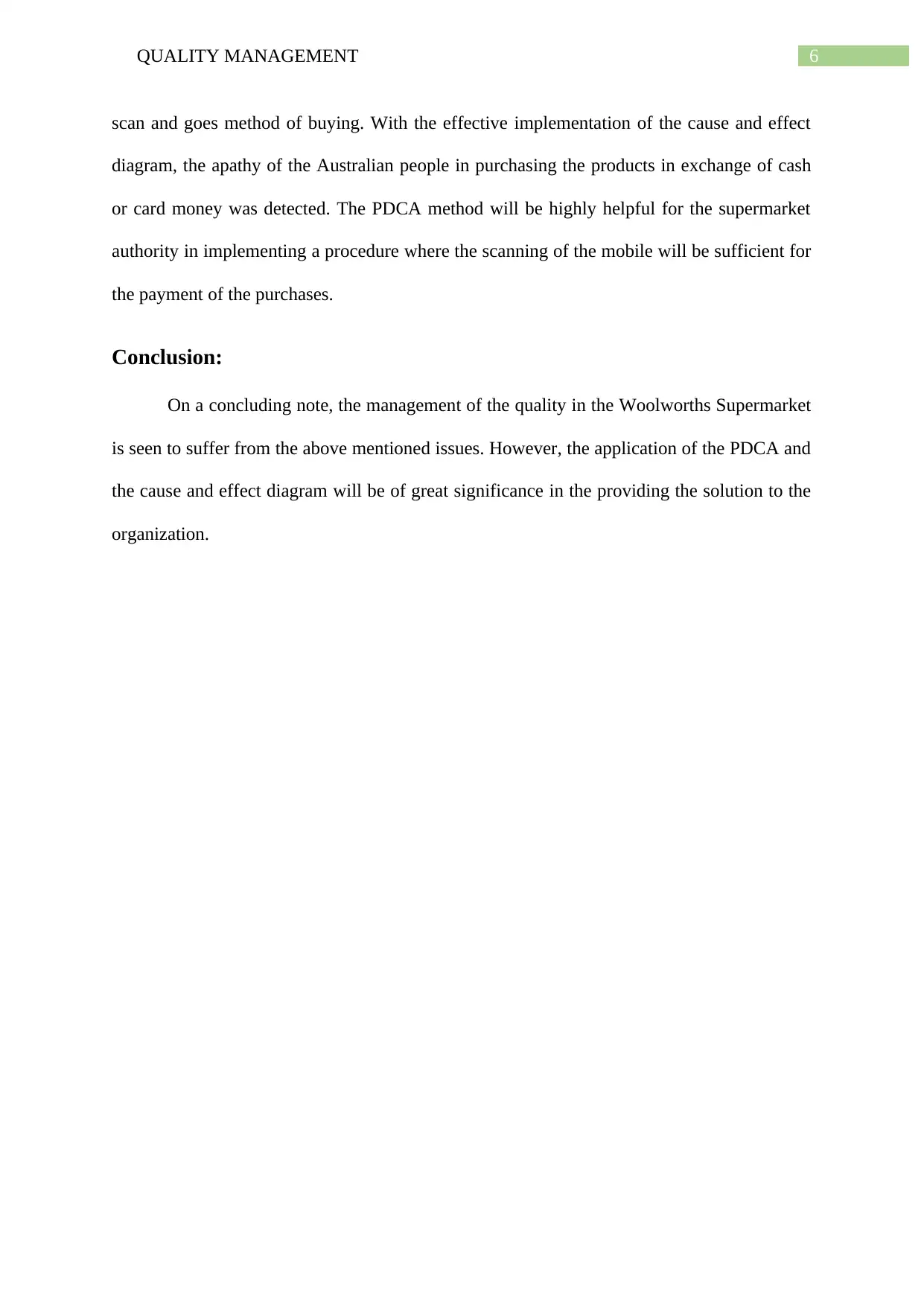
6QUALITY MANAGEMENT
scan and goes method of buying. With the effective implementation of the cause and effect
diagram, the apathy of the Australian people in purchasing the products in exchange of cash
or card money was detected. The PDCA method will be highly helpful for the supermarket
authority in implementing a procedure where the scanning of the mobile will be sufficient for
the payment of the purchases.
Conclusion:
On a concluding note, the management of the quality in the Woolworths Supermarket
is seen to suffer from the above mentioned issues. However, the application of the PDCA and
the cause and effect diagram will be of great significance in the providing the solution to the
organization.
scan and goes method of buying. With the effective implementation of the cause and effect
diagram, the apathy of the Australian people in purchasing the products in exchange of cash
or card money was detected. The PDCA method will be highly helpful for the supermarket
authority in implementing a procedure where the scanning of the mobile will be sufficient for
the payment of the purchases.
Conclusion:
On a concluding note, the management of the quality in the Woolworths Supermarket
is seen to suffer from the above mentioned issues. However, the application of the PDCA and
the cause and effect diagram will be of great significance in the providing the solution to the
organization.
Paraphrase This Document
Need a fresh take? Get an instant paraphrase of this document with our AI Paraphraser
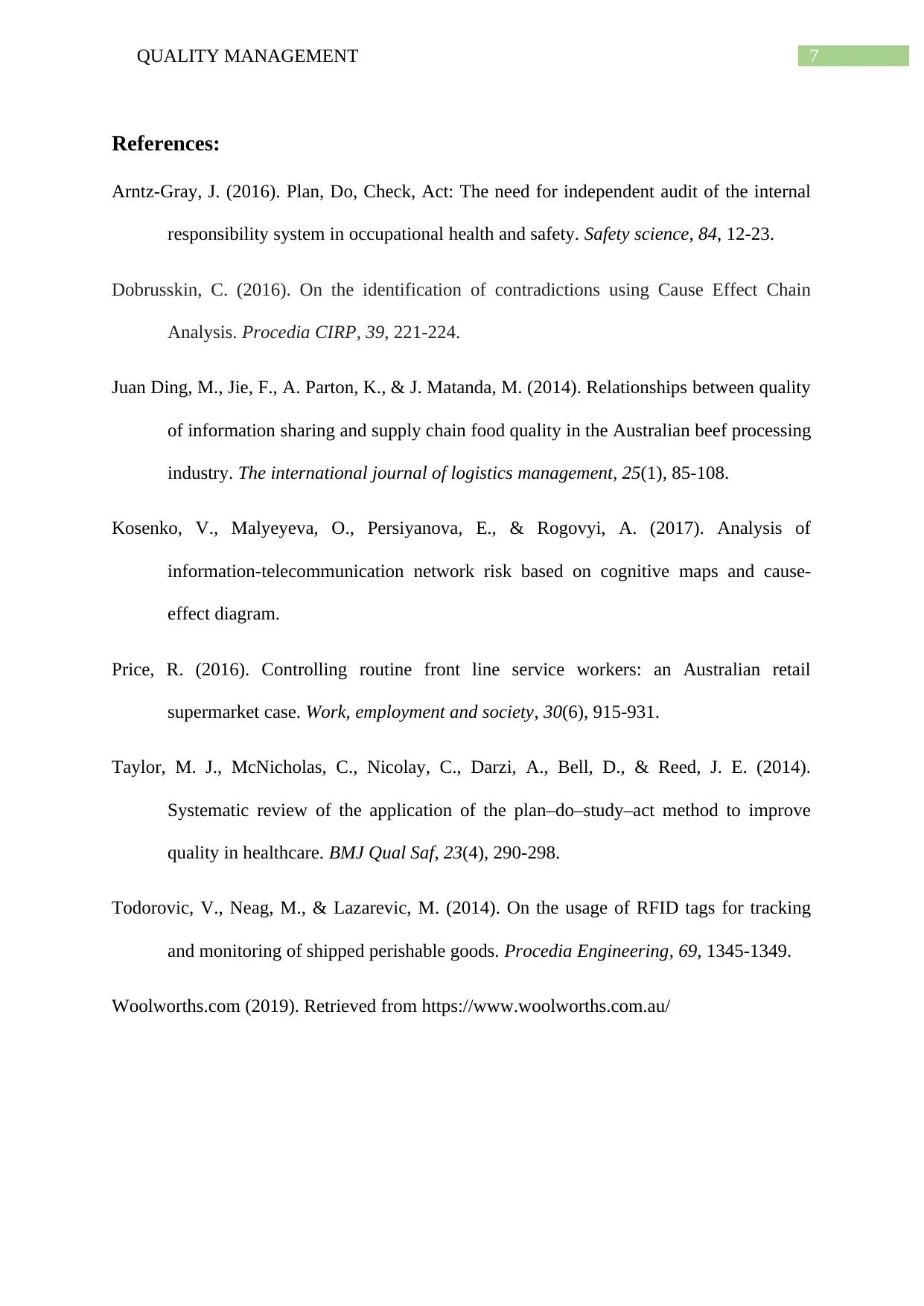
7QUALITY MANAGEMENT
References:
Arntz-Gray, J. (2016). Plan, Do, Check, Act: The need for independent audit of the internal
responsibility system in occupational health and safety. Safety science, 84, 12-23.
Dobrusskin, C. (2016). On the identification of contradictions using Cause Effect Chain
Analysis. Procedia CIRP, 39, 221-224.
Juan Ding, M., Jie, F., A. Parton, K., & J. Matanda, M. (2014). Relationships between quality
of information sharing and supply chain food quality in the Australian beef processing
industry. The international journal of logistics management, 25(1), 85-108.
Kosenko, V., Malyeyeva, O., Persiyanova, E., & Rogovyi, A. (2017). Analysis of
information-telecommunication network risk based on cognitive maps and cause-
effect diagram.
Price, R. (2016). Controlling routine front line service workers: an Australian retail
supermarket case. Work, employment and society, 30(6), 915-931.
Taylor, M. J., McNicholas, C., Nicolay, C., Darzi, A., Bell, D., & Reed, J. E. (2014).
Systematic review of the application of the plan–do–study–act method to improve
quality in healthcare. BMJ Qual Saf, 23(4), 290-298.
Todorovic, V., Neag, M., & Lazarevic, M. (2014). On the usage of RFID tags for tracking
and monitoring of shipped perishable goods. Procedia Engineering, 69, 1345-1349.
Woolworths.com (2019). Retrieved from https://www.woolworths.com.au/
References:
Arntz-Gray, J. (2016). Plan, Do, Check, Act: The need for independent audit of the internal
responsibility system in occupational health and safety. Safety science, 84, 12-23.
Dobrusskin, C. (2016). On the identification of contradictions using Cause Effect Chain
Analysis. Procedia CIRP, 39, 221-224.
Juan Ding, M., Jie, F., A. Parton, K., & J. Matanda, M. (2014). Relationships between quality
of information sharing and supply chain food quality in the Australian beef processing
industry. The international journal of logistics management, 25(1), 85-108.
Kosenko, V., Malyeyeva, O., Persiyanova, E., & Rogovyi, A. (2017). Analysis of
information-telecommunication network risk based on cognitive maps and cause-
effect diagram.
Price, R. (2016). Controlling routine front line service workers: an Australian retail
supermarket case. Work, employment and society, 30(6), 915-931.
Taylor, M. J., McNicholas, C., Nicolay, C., Darzi, A., Bell, D., & Reed, J. E. (2014).
Systematic review of the application of the plan–do–study–act method to improve
quality in healthcare. BMJ Qual Saf, 23(4), 290-298.
Todorovic, V., Neag, M., & Lazarevic, M. (2014). On the usage of RFID tags for tracking
and monitoring of shipped perishable goods. Procedia Engineering, 69, 1345-1349.
Woolworths.com (2019). Retrieved from https://www.woolworths.com.au/
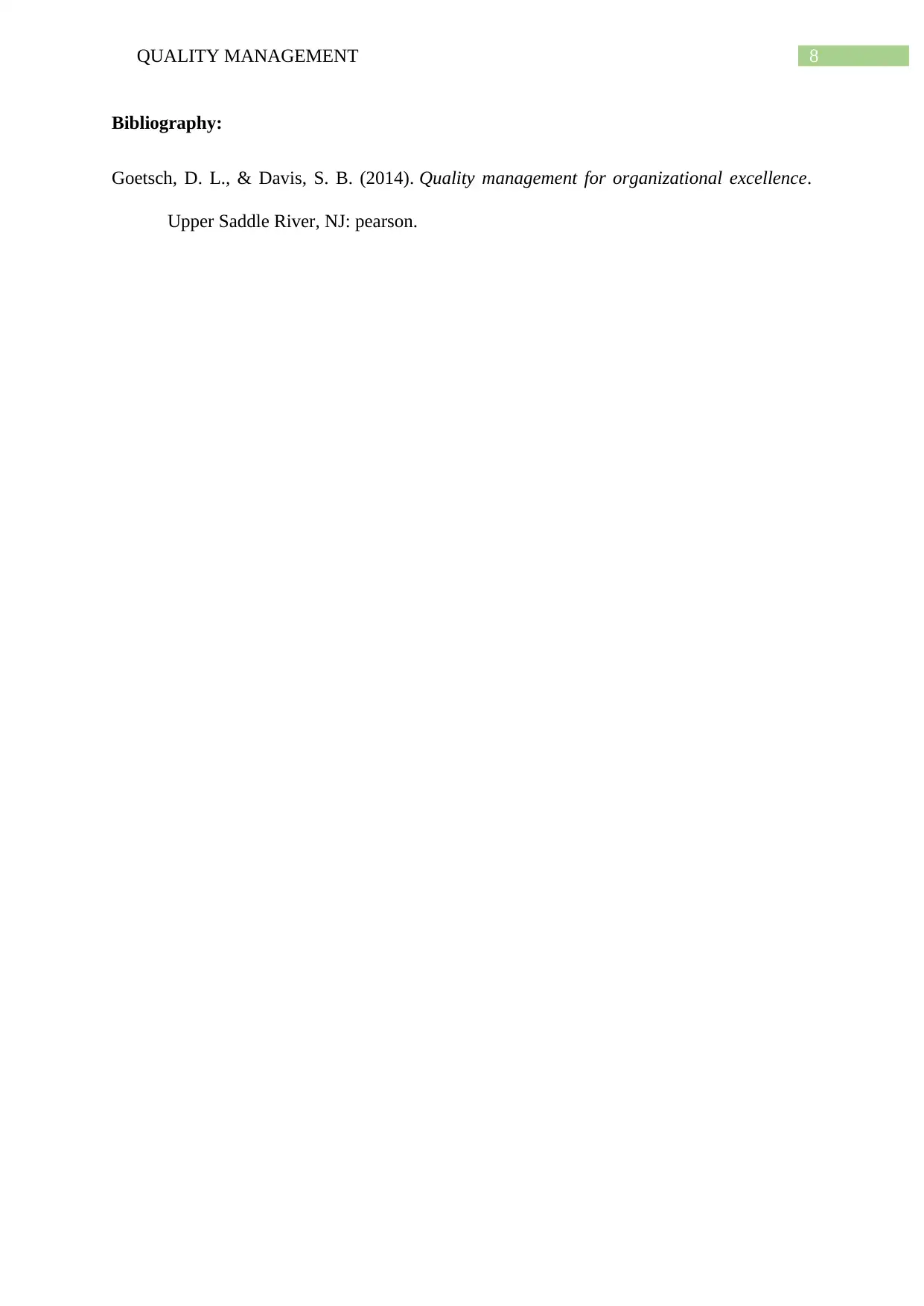
8QUALITY MANAGEMENT
Bibliography:
Goetsch, D. L., & Davis, S. B. (2014). Quality management for organizational excellence.
Upper Saddle River, NJ: pearson.
Bibliography:
Goetsch, D. L., & Davis, S. B. (2014). Quality management for organizational excellence.
Upper Saddle River, NJ: pearson.
⊘ This is a preview!⊘
Do you want full access?
Subscribe today to unlock all pages.

Trusted by 1+ million students worldwide
1 out of 9
Related Documents
Your All-in-One AI-Powered Toolkit for Academic Success.
+13062052269
info@desklib.com
Available 24*7 on WhatsApp / Email
![[object Object]](/_next/static/media/star-bottom.7253800d.svg)
Unlock your academic potential
Copyright © 2020–2025 A2Z Services. All Rights Reserved. Developed and managed by ZUCOL.




